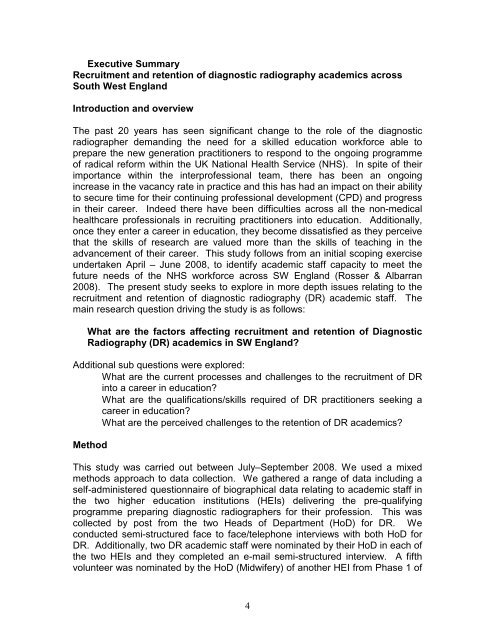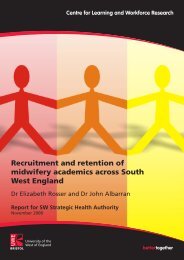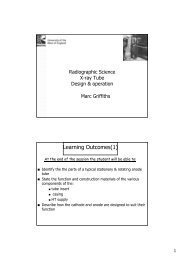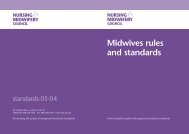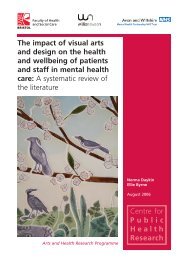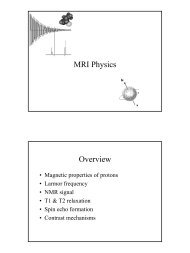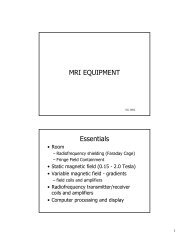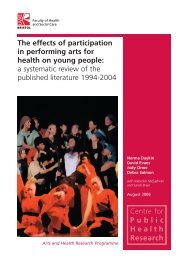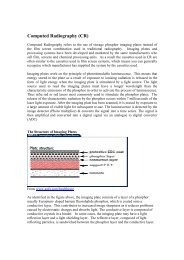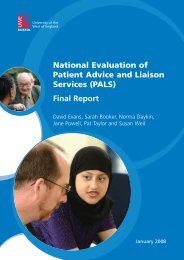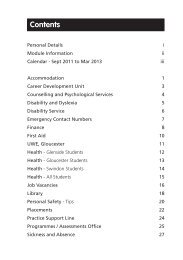Recruitment and retention of diagnostic radiography academics ...
Recruitment and retention of diagnostic radiography academics ...
Recruitment and retention of diagnostic radiography academics ...
- No tags were found...
You also want an ePaper? Increase the reach of your titles
YUMPU automatically turns print PDFs into web optimized ePapers that Google loves.
Executive Summary<strong>Recruitment</strong> <strong>and</strong> <strong>retention</strong> <strong>of</strong> <strong>diagnostic</strong> <strong>radiography</strong> <strong>academics</strong> acrossSouth West Engl<strong>and</strong>Introduction <strong>and</strong> overviewThe past 20 years has seen significant change to the role <strong>of</strong> the <strong>diagnostic</strong>radiographer dem<strong>and</strong>ing the need for a skilled education workforce able toprepare the new generation practitioners to respond to the ongoing programme<strong>of</strong> radical reform within the UK National Health Service (NHS). In spite <strong>of</strong> theirimportance within the interpr<strong>of</strong>essional team, there has been an ongoingincrease in the vacancy rate in practice <strong>and</strong> this has had an impact on their abilityto secure time for their continuing pr<strong>of</strong>essional development (CPD) <strong>and</strong> progressin their career. Indeed there have been difficulties across all the non-medicalhealthcare pr<strong>of</strong>essionals in recruiting practitioners into education. Additionally,once they enter a career in education, they become dissatisfied as they perceivethat the skills <strong>of</strong> research are valued more than the skills <strong>of</strong> teaching in theadvancement <strong>of</strong> their career. This study follows from an initial scoping exerciseundertaken April – June 2008, to identify academic staff capacity to meet thefuture needs <strong>of</strong> the NHS workforce across SW Engl<strong>and</strong> (Rosser & Albarran2008). The present study seeks to explore in more depth issues relating to therecruitment <strong>and</strong> <strong>retention</strong> <strong>of</strong> <strong>diagnostic</strong> <strong>radiography</strong> (DR) academic staff. Themain research question driving the study is as follows:What are the factors affecting recruitment <strong>and</strong> <strong>retention</strong> <strong>of</strong> DiagnosticRadiography (DR) <strong>academics</strong> in SW Engl<strong>and</strong>?Additional sub questions were explored:• What are the current processes <strong>and</strong> challenges to the recruitment <strong>of</strong> DRinto a career in education?• What are the qualifications/skills required <strong>of</strong> DR practitioners seeking acareer in education?• What are the perceived challenges to the <strong>retention</strong> <strong>of</strong> DR <strong>academics</strong>?MethodThis study was carried out between July–September 2008. We used a mixedmethods approach to data collection. We gathered a range <strong>of</strong> data including aself-administered questionnaire <strong>of</strong> biographical data relating to academic staff inthe two higher education institutions (HEIs) delivering the pre-qualifyingprogramme preparing <strong>diagnostic</strong> radiographers for their pr<strong>of</strong>ession. This wascollected by post from the two Heads <strong>of</strong> Department (HoD) for DR. Weconducted semi-structured face to face/telephone interviews with both HoD forDR. Additionally, two DR academic staff were nominated by their HoD in each <strong>of</strong>the two HEIs <strong>and</strong> they completed an e-mail semi-structured interview. A fifthvolunteer was nominated by the HoD (Midwifery) <strong>of</strong> another HEI from Phase 1 <strong>of</strong>4


